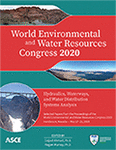World Environmental and Water Resources Congress 2020
Optimizing Tank Design to Improve THM Removal with Spray Aeration
This article has been corrected.
VIEW CORRECTIONPublication: World Environmental and Water Resources Congress 2020: Hydraulics, Waterways, and Water Distribution Systems Analysis
ABSTRACT
Chlorination is applied as a primary and/or secondary disinfectant to avoid outbreaks of waterborne-diseases in drinking water supplies. Besides the desired effect of inactivating pathogens, chlorine also reacts with natural organic matter and precursors in raw water to form various disinfection by-products (DBPs), such as trihalomethanes (THMs). Spray aeration is a post-treatment method commonly employed in distribution systems to remove THMs from the water. It is known that to effectively remove THMs in relatively enclosed systems, proper ventilation is required to evacuate the contaminated air. Using a pilot-scale tank, this study assessed the effect of tank design parameters on the removal of the individual THM species. The parameters included air flow rate, blower angle, and vent location. In addition, model simulations were conducted with computational fluid dynamics software to observe the air stream path in the headspace as the aforementioned parameters were modified. It was observed that THM removal varied under different conditions. For example, locating the vent near the spray aeration nozzle (center of the tank) resulted in slightly lower removal compared to other vent locations. Additionally, blower angle induced <5% difference in total THM removals. Higher air flow rates increased THM removal up to ~70%; dibromochloromethane was the most receptive to increased air flow rate, followed by bromoform, dibromochloromethane, bromodichloromethane, and chloroform. These findings indicate that optimizing parameters associated with the blower and vents can enhance THM removal in storage tanks employing spray aeration processes. Therefore, air flow rate and vent placement should be carefully considered during construction and retrofitting of storage tanks with spray aeration systems.
Get full access to this article
View all available purchase options and get full access to this chapter.
REFERENCES
AWWA. (1997). AWWA Standard for Welded Steel Tanks for Water Storage. American Water Works Association.
Bellar, T. A., Lichtenberg, J. J., & Kroner, R. C. (1974). The Occurrence of Organohalides in Chlorinated Drinking, 66(12), 703–706.
Bilello, L. J., & Singley, J. E. (1986). Removing trihalomethanes by packed-column and diffused aeration. Journal / American Water Works Association, 78(2), 62–71.
Brooke, E., & Collins, M. R. (2011). Posttreatment aeration to reduce THMs. Journal – American Water Works Association, 103(10), 84–96. https://doi.org/10.1002/j.1551-8833.2011.tb11550.x
Cecchetti, A. R., Roakes, H., & Collins, M. R. (2014). Influence of selected variables on trihalomethane removals by spray aeration. Journal - American Water Works Association, 106(5), 91–92. https://doi.org/10.5942/jawwa.2014.106.0021
Clark, T. F. (2016). DBP Control in an Expanding Regional Water Supply System; DBP Control in an Expanding Regional Water Supply System.
Duranceau, S. J., & Smith, C. T. (2016). Trihalomethane Formation Downstream of Spray Aerators Treating Disinfected Groundwater. Journal - American Water Works Association, 108(2), E99–E108. https://doi.org/10.5942/jawwa.2016.108.0007
Krasner, S. W., Weinberg, H. S., Richardson, S. D., Pastor, S. J., Chinn, R., Sclimenti, M. J., ... & Thruston, A. D. (2006). Occurrence of a new generation of disinfection byproducts. Environmental science & technology, 40(23), 7175-7185.
Legay, C., Rodriguez, M. J. B., Sérodes, J., & Levallois, P. (2010). The assessment of population exposure to chlorination by-products: A study on the influence of the water distribution system. Environmental Health: A Global Access Science Source, 9(1), 1–14.
Plewa, M. J., Kargalioglu, Y., Vankerk, D., Minear, R. A., & Wagner, E. D. (2002). Mammalian cell cytotoxicity and genotoxicity analysis of drinking water disinfection by-products. Environmental and molecular mutagenesis, 40(2), 134-142.
Richardson, S. D., Plewa, M. J., Wagner, E. D., Schoeny, R., & DeMarini, D. M. (2007). Occurrence, genotoxicity, and carcinogenicity of regulated and emerging disinfection byproducts in drinking water: A review and roadmap for research. Mutation Research - Reviews in Mutation Research, 636(1–3), 178–242. https://doi.org/10.1016/j.mrrev.2007.09.001
Roberts, P. V, & Levy, J. A. (1985). Energy Requirements for Air Stripping Trihalomethanes. Journal - American Water Works Association, 77(4), 138.
Sander, R. (2015). Compilation of Henry’s law constants (version 4.0) for water as solvent. Atmospheric Chemistry and Physics, 15(8), 4399–4981. https://doi.org/10.5194/acp-15-4399-2015
Information & Authors
Information
Published In
World Environmental and Water Resources Congress 2020: Hydraulics, Waterways, and Water Distribution Systems Analysis
Pages: 374 - 384
Editors: Sajjad Ahmad, Ph.D., and Regan Murray, Ph.D.
ISBN (Online): 978-0-7844-8297-1
Copyright
© 2020 American Society of Civil Engineers.
History
Published online: May 14, 2020
Published in print: May 14, 2020
Authors
Metrics & Citations
Metrics
Citations
Download citation
If you have the appropriate software installed, you can download article citation data to the citation manager of your choice. Simply select your manager software from the list below and click Download.
